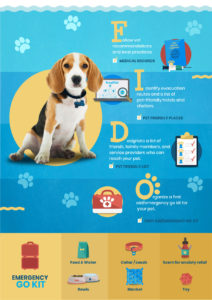PET PREPAREDNESS
Make a Plan
If you have a plan in place for you and your pets, you will likely encounter less difficulty, stress and worry when you need to make a decision during an emergency. If local officials ask you to evacuate, that means your pet should evacuate too. If you leave your pets behind, they may end up lost, injured or worse.
Things to include in your plan:
- Have an evacuation plan for your pet. Many public shelters and hotels do not allow pets inside. Know a safe place where you can take your pets before disasters and emergencies happen.
- Develop a buddy system. Plan with neighbors, friends or relatives to make sure that someone is available to care for or evacuate your pets if you are unable to do so.
- Have your pet microchipped. Make sure to keep your address and phone number up-to-date and include contact information for an emergency contact outside of your immediate area.
- Contact your local emergency management office, animal shelter or animal control office to get additional advice and information if you’re unsure how to care for your pet in case of an emergency.
PET EMERGENCY KITS
-
- Food. Keep several days’ supply of food in an airtight, waterproof container.

- Water. Store a water bowl and several days’ supply of water.
- Medicine. Keep an extra supply of the medicine your pet takes on a regular basis in a waterproof container.
- First aid kit. Talk to your veterinarian about what is most appropriate for your pet’s emergency medical needs.
- Collar with ID tag and a harness or leash. Include a backup leash, collar and ID tag. Have copies of your pet’s registration information and other relevant documents in a waterproof container and available electronically.
- Food. Keep several days’ supply of food in an airtight, waterproof container.
Your emergency plans should include places to go and stay with family or friends outside of your region. Remember shelters should be your last resort. DO NOT LEAVE YOUR PETS BEHIND.
don’t forget f.i.d.o!

Tips for Large Animals
If you have pets such as horses, goats or pigs on your property, be sure to prepare before a disaster.
- Ensure all animals have some form of identification.
- Evacuate animals earlier, whenever possible. Map out primary and secondary routes in advance.
- Make available vehicles and trailers needed for transporting and supporting each type of animal. Also make available experienced handlers and drivers.
- Ensure destinations have food, water, veterinary care and handling equipment.
- If evacuation is not possible, animal owners must decide whether to move large animals to a barn or turn them loose outside.
For more information go to:
- http://ready.gov
- http://www.cdc.gov
- http://www.fema.gov
- http://www.redcross.org
- https://www.aspca.org/pet-care/general-pet-care/disaster-preparedness
